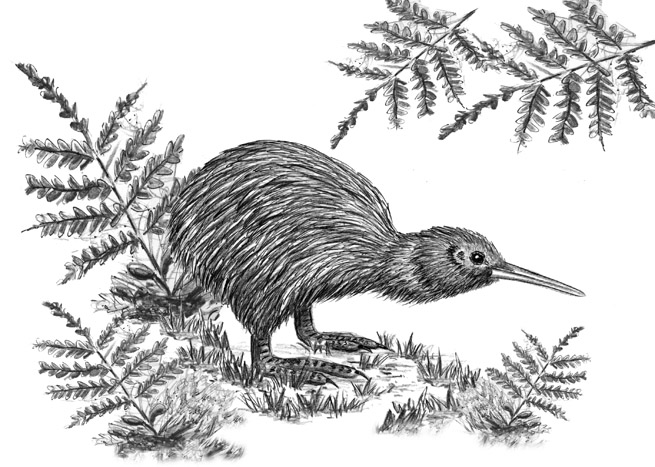
Dear Bird Folks,
I’m taking a bus tour around New Zealand at the end of October. I won’t have a lot of time to do any serious bird watching, but I’d like to see a kiwi while I’m there. Are they hard to find? Do you think I’ll see one?
– Jim, Brooklyn, NY
They are lucky, Jim,
The people in New Zealand are totally lucky. They live in a small, isolated country and yet they have their very own signature bird, the kiwi. Most other signature birds are reserved for continents. For example: Africa has ostriches, Asia has peacocks, Antarctica has penguins and North America has Chick-fil-A. New Zealanders are so proud of kiwis they even refer to themselves as “Kiwis.” How cool is that? I wish the U.S. had a bird nickname. It would be much better than being called a “Yankee.” I’d rather be called a “grackle” than a Yankee. But as usual I may be alone on this one.
If you saw a kiwi for the very first time, you’d have trouble trying to figure out what it was. Kiwis certainly don’t look like birds. They have fat, pear-shaped bodies (making them seem like they are born middle-aged). They have no visible wings, sturdy legs and longs beaks, and they’re shabby feathers look like the fur on a wet dog. From a distance, or even up close, kiwis look like a cross between a small heron and a muskrat. For centuries these freaky birds had it made. They lived in a world with virtually no predators. There were no hungry mammals or nasty snakes to deal with. The birds felt so safe on the ground that they didn’t learn to fly or even bother growing useful wings.
Kiwis spend their days sleeping in burrows and spend their nights looking for worms. How can they find worms in the dark, you ask? Most normal birds have their nostrils high up on the beak, but of course kiwis aren’t normal birds. A kiwi is able to find worms in the dark because its nose is at the end of its beak. Birds typically have a poor sense of smell, but kiwis are like avian bloodhounds. They can smell a worm six inches below the surface. For centuries these goofy birds lived idyllic lives. They slept all day, munched worms at night and occasionally earned extra cash selling shoe polish. But then you-know-who came along and things got ugly in a hurry.
When humans first arrived in New Zealand they were knee-deep in kiwis. Some estimates put the number at 70 millions. (In a country as small as New Zealand, that’s a lot of kiwis.) Today that number has dropped into the thousands. (In a country as large as New Zealand, that’s not a lot of kiwis.) Many birds were lost when their forest homes were cut down to create farmland, while others were killed by hunters who had a taste for kiwi-kebobs. But the biggest problem has been the introduced pigs, cats, stoats (weasels) and dogs. I usually blame all of the world’s problems on cats. It makes perfect sense to me. But in this case dogs are also a big problem. Even though the chicken-sized kiwis are flightless, they are pretty good at defending themselves with their strong feet and sharp claws. But dogs are simply too powerful for a bird that evolved in a mammal-free world. Each year hundreds of rare kiwis are killed by pet dogs. (You know you are having a bad day when your dog comes home with a lifeless national symbol.) Human Kiwis are working hard to protect avian kiwis, but it’s not easy. These birds only lay one or two eggs a year and the babies take forever to hatch. Kiwis have a low body temperature (for a bird) and thus it takes several months of incubation before kiwi, Jr. is big enough to break through its shell. Once out of the shell the little kiwis have to dodge the pigs, cats, dogs and stoats, a task that they aren’t very good at doing. Ninety-five percent of all young kiwis fall victim to these introduced predators. (Oh, man. How grim is this column? Maybe I should have saved it for Halloween.)
On a lighter note, your question reminds me of my own long-ago visit to New Zealand. Although I wasn’t on a bus tour, my birding was also limited. My wife and I were traveling with our then two-month-old daughter, who didn’t like being left alone in the hotel room while her parents went birding. (Kids can be so needy.) So instead, I would go out each night and walk around the local neighborhood with a flashlight, looking in peoples’ yards for kiwis. Back then I was too dumb to know that kiwis had long been driven out of populated areas. It was like walking through the streets of Brooklyn looking for Whooping Cranes. What a bonehead. I’m lucky I wasn’t arrested.
Will you see wild kiwis on your bus tour? No, not likely. The few remaining birds live on offshore islands and in isolated pockets away from civilization. However, there are organized kiwi tours. If you break away from the bus for a few days, you could hook up with one. With the right tour your odds of seeing a wild kiwi are excellent and you probably won’t be arrested.
Have fun in New Zealand, Jim. It’s not really the best country for birding, but what it lacks in birds New Zealand more than makes up for in beauty and delicious fruit. You shouldn’t have trouble finding kiwi, the fruit. It’s everywhere. However, unlike the bird, the fruit isn’t a native of New Zealand. Kiwifruit is actually a form of gooseberry, which was imported from China…just like everything else.